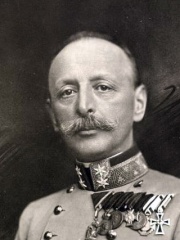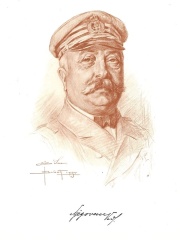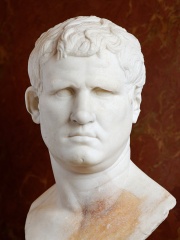
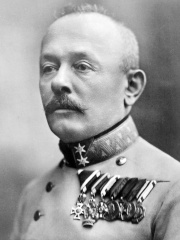
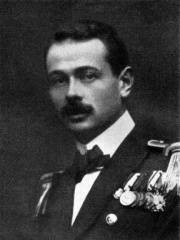
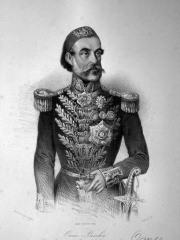
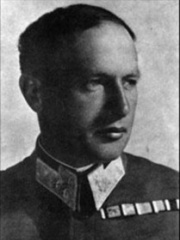
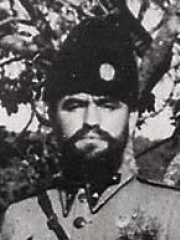
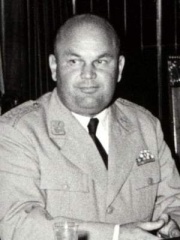
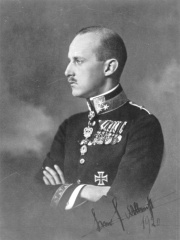
The Most Famous
MILITARY PERSONNELS from Croatia
This page contains a list of the greatest Croatian Military Personnels. The pantheon dataset contains 2,058 Military Personnels, 17 of which were born in Croatia. This makes Croatia the birth place of the 16th most number of Military Personnels behind Austria, and India.
Top 10
The following people are considered by Pantheon to be the top 10 most legendary Croatian Military Personnels of all time. This list of famous Croatian Military Personnels is sorted by HPI (Historical Popularity Index), a metric that aggregates information on a biography's online popularity. Visit the rankings page to view the entire list of Croatian Military Personnels.

1. Marcus Vipsanius Agrippa (63 BC - 12 BC)
With an HPI of 79.19, Marcus Vipsanius Agrippa is the most famous Croatian Military Personnel. His biography has been translated into 62 different languages on wikipedia.
Marcus Vipsanius Agrippa (; c. 63 BC – 12 BC) was a Roman general and statesman who was a close friend, son-in-law and lieutenant to the Roman emperor Augustus. Agrippa is well known for his important military victories, notably the Battle of Actium in 31 BC against the forces of Mark Antony and Cleopatra. He was also responsible for the construction of some of the most notable buildings of his era, including the original Pantheon. Born to a plebeian family c. 63 BC, in an uncertain location in Roman Italy, he met the future emperor Augustus, then known as Octavian, at Apollonia, in Illyria. Following the assassination of Octavian's great-uncle Julius Caesar in 44 BC, Octavian returned to Italy. Around this time, Agrippa was elected tribune of the plebs. He served as a military commander, fighting alongside Octavian and Caesar's former general and right-hand man Mark Antony in the Battle of Philippi. In 40 BC, he was praetor urbanus and played a major role in the Perusine war against Lucius Antonius and Fulvia, respectively the brother and wife of Mark Antony. In 39 or 38 BC, Agrippa was appointed governor of Transalpine Gaul. In 38 BC, he put down a rising of the Aquitanians and fought the Germanic tribes. He was made consul for 37 BC, despite being well below the usual minimum age of 43, in order to oversee the preparations for war against Sextus Pompey, who had cut off grain shipments to Rome. Agrippa defeated Pompey in the battles of Mylae and Naulochus in 36 BC. In 33 BC, he served as curule aedile. Agrippa commanded the victorious Octavian's fleet at the Battle of Actium in 31 BC. A few years after the victory at Actium, Octavian became emperor and took the title of Princeps, while Agrippa remained as his close friend and lieutenant. Agrippa assisted Augustus in making Rome "a city of marble". Agrippa renovated aqueducts to provide Roman citizens from every social class access to the highest quality public services, and was responsible for the creation of many baths, porticoes, and gardens. He was also awarded powers almost as great as those of Augustus. He had veto power over the acts of the Senate and the power to present laws for approval by the People. He died in 12 BC at the age of 50–51. Augustus honoured his memory with a magnificent funeral and spent over a month in mourning. His remains were placed in Augustus' own mausoleum. Agrippa was also known as a writer, especially on geography. Under his supervision, Julius Caesar's design of having a complete survey of the empire made was accomplished. From the materials at hand he constructed a circular chart, which was engraved on marble by Augustus and afterwards placed in the colonnade built by his sister Vipsania Polla. Agrippa was also husband to Julia the Elder (who had later married the second Emperor Tiberius), and was the maternal grandfather of Caligula and the maternal great-grandfather of the Emperor Nero.

2. Svetozar Boroević (1856 - 1920)
With an HPI of 70.08, Svetozar Boroević is the 2nd most famous Croatian Military Personnel. His biography has been translated into 29 different languages.
Svetozar Boroević von Bojna (or Borojević) (13 December 1856 – 23 May 1920) was an Austro-Hungarian field marshal who was described as one of the finest defensive strategists of the First World War. He commanded Austro-Hungarian forces in the Isonzo front, for which he was nicknamed the "Lion of Isonzo". For his service during the First World War, Boroević rose to the rank of Feldmarschall before the end of the war in 1918, becoming the first and only Austro-Hungarian field marshal of South Slavic descent.

3. Georg von Trapp (1880 - 1947)
With an HPI of 69.46, Georg von Trapp is the 3rd most famous Croatian Military Personnel. His biography has been translated into 24 different languages.
Georg Ludwig Ritter von Trapp (4 April 1880 – 30 May 1947) was an officer in the Austro-Hungarian Navy who became the patriarch of the Trapp Family Singers. After their naturalisation as US citizens, the family name was changed to 'Trapp' without the 'von'. Trapp was the most successful Austro-Hungarian submarine commander of World War I, sinking 11 Allied merchant ships totaling 47,653 GRT and two Allied warships displacing 12,641 tons. Trapp's accomplishments during World War I earned him numerous decorations, including the Military Order of Maria Theresa. His first wife Agathe Whitehead died of scarlet fever in 1922, leaving behind seven children. Trapp hired Maria Augusta Kutschera to tutor one of his daughters and married her in 1927. He lost most of his wealth in the Great Depression, so the family turned to singing as a way of earning a livelihood. Trapp declined a commission in the German Navy after the Anschluss and emigrated with his family to the United States. After his death in 1947, the family home in Stowe, Vermont, became the Trapp Family Lodge. Maria von Trapp's 1949 memoir The Story of the Trapp Family Singers was adapted into the West German film The Trapp Family (1956), which served as the basis for the Rodgers and Hammerstein musical The Sound of Music (1959) and the 1965 film adaptation directed by Robert Wise.

4. Omar Pasha (1806 - 1871)
With an HPI of 68.58, Omar Pasha is the 4th most famous Croatian Military Personnel. His biography has been translated into 30 different languages.
Omer Pasha, also known as Omer Pasha Latas (Turkish: Ömer Lütfi Paşa, Serbian: Омер-паша Латас, romanized: Omer-paša Latas; 24 September 1806 – 18 April 1871) was an Ottoman field marshal and governor. Born in the Austrian Empire to Serbian Orthodox Christian parents, he initially served as an Austrian soldier. When faced with charges of embezzlement, he fled to Ottoman Bosnia in 1823 and converted to Islam; he then joined the Ottoman army, where he quickly rose through the ranks. Latas crushed several rebellions all across the Ottoman Empire. He served as the main commander of the Crimean War, where he defeated the Russians at Giurgevo, regaining control of Bucharest and the Danubian Principalities, pushing the Russians outside of the Danube. Latas spearheaded notable victories at Oltenița, Cetate, Eupatoria, Sukhumi, and Sevastopol. As a commander, he was noted for his excellent strategic and diplomatic skills.
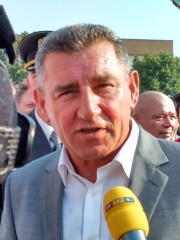
5. Ante Gotovina (b. 1955)
With an HPI of 66.26, Ante Gotovina is the 5th most famous Croatian Military Personnel. His biography has been translated into 34 different languages.
Ante Gotovina (born 12 October 1955) is a Croatian retired lieutenant general and former French senior corporal who served in the Croatian War for Independence. He is noted for his primary role in the 1995 Operation Storm. In 2001, the International Criminal Tribunal for the former Yugoslavia (ICTY) indicted him on war crimes and crimes against humanity charges in connection with that operation and its aftermath. After spending four years in hiding, he was captured in the Canary Islands in December 2005. On 15 April 2011, Gotovina was found guilty on 8 of the 9 counts of the indictment and sentenced to 24 years of imprisonment. On 16 November 2012, Gotovina's convictions were overturned by an appeals panel at the International Criminal Tribunal for the former Yugoslavia (ICTY) and he was released from custody.

6. Viktor Pavičić (1898 - 1943)
With an HPI of 65.11, Viktor Pavičić is the 6th most famous Croatian Military Personnel. His biography has been translated into 15 different languages.
Viktor Pavičić (15 October 1898 – 20 January 1943) was a Croatian military commander who led the 369th Reinforced Croatian Infantry Regiment, which fought on the Eastern Front and was involved in the Battle of Stalingrad during World War II.

7. Momčilo Đujić (1907 - 1999)
With an HPI of 63.40, Momčilo Đujić is the 7th most famous Croatian Military Personnel. His biography has been translated into 16 different languages.
Momčilo Đujić (Serbo-Croatian Cyrillic: Момчилo Ђујић, pronounced [mǒmtʃiːlo dʑûːjitɕ]; 27 February 1907 – 11 September 1999) was a Serbian Orthodox priest and Chetnik vojvoda. He led a significant proportion of the Chetniks within the northern Dalmatia and western Bosnia regions of the Independent State of Croatia (NDH), a fascist puppet state created from parts of the occupied Kingdom of Yugoslavia during World War II. In this role he collaborated extensively with the Italian and then the German occupying forces against the communist-led Partisan insurgency. Đujić was ordained as a priest in 1933 and gained a reputation as something of a firebrand in the pulpit. After the assassination of King Alexander of Yugoslavia in 1934, he joined the Chetnik Association of Kosta Pećanac, forming several bands in the Knin region of Dalmatia. The Chetnik Association became a reactionary force used by the central government to oppress the populace. Active in promoting workers' rights, Đujić was briefly jailed for leading a protest by railroad workers, and he was a member of the exclusively-Serb Agrarian Union political party. After the Axis invasion of Yugoslavia in April 1941, the Croatian Ustaše regime implemented a policy of widespread incarcerations, massacres, forced emigration and murder of Serbs and other groups, but Đujić escaped to the coastal zone annexed by Italy and began recruiting Chetniks in a refugee camp. When a general uprising began in August, Đujić returned to Knin and deployed his Chetniks to defend local Serbs from the Ustaše, and under his command they captured the town of Drvar in the Bosanska Krajina. He then quickly began collaborating with the Italians, gaining their help through signing a non-aggression agreement. At this time, he was still aligned with the insurgency led by the communists. He soon betrayed them and began subverting Partisan units and attacking them alongside the Italians. He formed the Chetnik Dinara Division in early 1942. By mid-1942, Đujić was encouraging his Chetniks to co-operate with NDH forces, and on 1 October Chetniks under his command perpetrated a massacre of nearly 100 Croat civilians in the village of Gata. In early 1943 he attempted to participate on the Axis side in the Case White campaign against the Partisans but this was blocked by the Germans. In August, the Dinara Division suffered significantly at the hands of the Partisans and through desertion. By the time of the Italian capitulation in September it was of little use for offensive operations. When the Germans occupied the area, they restricted it to guarding railway tracks from Partisan sabotage. By November 1943, the Chetnik supreme commander, Draža Mihailović, was ordering Đujić to collaborate with the Germans. In November 1944, Đujić and 4,500 of his Chetniks combined with German and NDH forces in an attempt to defend Knin from the ascendant Partisans. Đujić progressively withdrew his troops until they surrendered to the western Allies in May 1945. Đujić was tried and convicted in absentia for war crimes by the new Yugoslav communist government, which found him guilty of mass murder, torture, rape, robbery, forcible confinement and collaborating with the occupying forces. Included in these charges was responsibility for the deaths of 1,500 people. He eventually emigrated to the United States, settling in California. He played an important role in Serbian émigré circles and founded the Ravna Gora Movement of Serbian Chetniks alongside other exiled Chetnik fighters. He later retired to San Marcos, California. In 1989, Đujić appointed the ultranationalist Serb politician Vojislav Šešelj as a Chetnik vojvoda. He later stated that he regretted awarding the title to Šešelj due to his involvement with Slobodan Milošević and his Socialist Party. In 1998, Biljana Plavšić, then President of Republika Srpska, presented Đujić with an honorary award. Plavšić was later convicted of crimes against humanity related to her activities during the Bosnian War. Đujić died at a hospice in San Diego in 1999, aged 92. Moves in Serbia to rehabilitate the reputations of Đujić and the Chetnik movement have been criticised as historical revisionism and falsification of history.

8. Janko Bobetko (1919 - 2003)
With an HPI of 63.11, Janko Bobetko is the 8th most famous Croatian Military Personnel. His biography has been translated into 19 different languages.
Janko Bobetko (10 January 1919 – 29 April 2003) was a Croatian general who had participated in World War II and later in the Croatian War of Independence. He was one of the founding members of 1st Sisak Partisan Detachment, the first anti-fascist military unit during World War II in Yugoslavia. He later had a military career in the Yugoslav People's Army (JNA). In 1992, Bobetko became the Chief of the General Staff of the Croatian Army (HV). He served in this capacity until his retirement in 1995. Bobetko had been charged with war crimes by the International Criminal Tribunal for the former Yugoslavia but died before he could be tried; a later verdict in another case found that he took part in the joint criminal enterprise against the non-Croat population during the Bosnian War.

9. Archduke Karl Albrecht of Austria (1888 - 1951)
With an HPI of 60.90, Archduke Karl Albrecht of Austria is the 9th most famous Croatian Military Personnel. His biography has been translated into 16 different languages.
Archduke Karl Albrecht of Austria-Teschen (Karl Albrecht Nikolaus Leo Gratianus von Österreich, later Karl Albrecht Habsburg-Lothringen, since 1919 – Karol Olbracht Habsburg-Lotaryński; 18 December 1888 – 17 March 1951) was an Austrian military officer, a member of the Teschen line of the House of Habsburg-Lorraine.
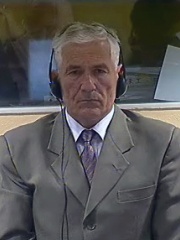
10. Mile Mrkšić (1947 - 2015)
With an HPI of 60.88, Mile Mrkšić is the 10th most famous Croatian Military Personnel. His biography has been translated into 17 different languages.
Mile Mrkšić (Serbian Cyrillic: Миле Мркшић; 1 May 1947 – 16 August 2015) was a colonel of the Yugoslav People's Army (JNA) in charge of the unit involved in the Battle of Vukovar during the Croatian War of Independence in 1991. He was convicted for not preventing the mass killing of 264 Croats that followed the fall of Vukovar, and sentenced to 20 years.
People
Pantheon has 17 people classified as Croatian military personnels born between 63 BC and 1955. Of these 17, 1 (5.88%) of them are still alive today. The most famous living Croatian military personnels include Ante Gotovina. The most famous deceased Croatian military personnels include Marcus Vipsanius Agrippa, Svetozar Boroević, and Georg von Trapp.
Living Croatian Military Personnels
Go to all RankingsDeceased Croatian Military Personnels
Go to all RankingsMarcus Vipsanius Agrippa
63 BC - 12 BC
HPI: 79.19
Svetozar Boroević
1856 - 1920
HPI: 70.08
Georg von Trapp
1880 - 1947
HPI: 69.46
Omar Pasha
1806 - 1871
HPI: 68.58
Viktor Pavičić
1898 - 1943
HPI: 65.11
Momčilo Đujić
1907 - 1999
HPI: 63.40
Janko Bobetko
1919 - 2003
HPI: 63.11
Archduke Karl Albrecht of Austria
1888 - 1951
HPI: 60.90
Mile Mrkšić
1947 - 2015
HPI: 60.88
Jure Francetić
1912 - 1942
HPI: 60.85
Stjepan Sarkotić
1858 - 1939
HPI: 60.73
Maximilian Njegovan
1858 - 1930
HPI: 60.55
Overlapping Lives
Which Military Personnels were alive at the same time? This visualization shows the lifespans of the 15 most globally memorable Military Personnels since 1700.


